Constantine's Bronze Statue in His Forum in Constantinople
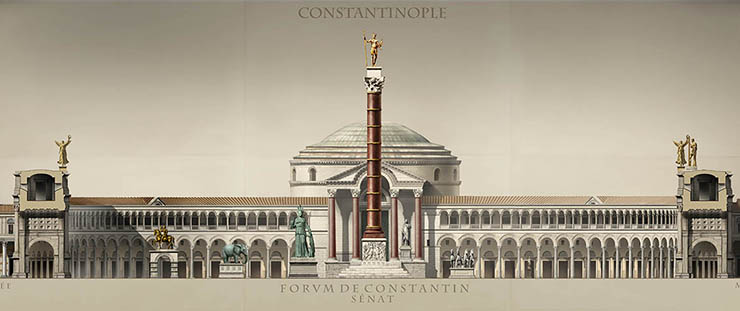 Above is a reconstruction of the Forum of Constantine with his column in the center. Constantine's Forum was filled with beautiful bronze statues from ancient Greece and Rome. The most famous was the Athena Promachos - "Athena who fights in the front line" - by Pheidias from the Athenian acropolis was brought to the Forum sometime after 465 AD and can been seen to the left of the great column in the reconstruction above. There were many other statues in the Forum including an Aphrodite, a Thetis and an Artemis; and many of animals like dophins and an awe-inspiring elephant. The Forum also had 12 gilded hippocamps, mythical creatures which most people called sea horses.
Above is a reconstruction of the Forum of Constantine with his column in the center. Constantine's Forum was filled with beautiful bronze statues from ancient Greece and Rome. The most famous was the Athena Promachos - "Athena who fights in the front line" - by Pheidias from the Athenian acropolis was brought to the Forum sometime after 465 AD and can been seen to the left of the great column in the reconstruction above. There were many other statues in the Forum including an Aphrodite, a Thetis and an Artemis; and many of animals like dophins and an awe-inspiring elephant. The Forum also had 12 gilded hippocamps, mythical creatures which most people called sea horses.
The red Porphyry column was erected by Constantine the Great in his circular Forum in 328, where it still stands. It was not a monolith and was 140 feet tall with its capital and base The gilded statue on the top added another 20 feet to it. It was made of seven colossal 10 feet tall blocks - 63 tons each - of red Porphyry fitted together with bands of laurel leaves. They had trouble with the column from the start. In 416 a large part of the bottom drum split off and was smashed on the floor of the forum. The gash was never filled in and the entire column was encased in a bronze lattice to keep it together. One theory about its origin is that the column parts were intended for a monument to the emperor Diocletian that was never completed. It still survives, battered and humiliated in old-Istanbul. It's interesting that Constantine's column was higher than Trajan's great column in Rome.
Constantine had a colossal - 30+ ft tall - nude and gilded bronze statue of himself placed on a gigantic, brilliant purple, porphyry column at the center of his forum in Constantinople (the column can still be seen today - a complete ruin). He was crowned like the god Helios with sun rays. It has been speculated that later generations were embarrassed by Constantine's nudity as the first Christian Emperor and tended to ignore the statue. The statue would have been a very hard thing to ignore. More than one ancient historian reported the statue was brought to the forum from the city of Troy, in Asia Minor. However, Cyril Mango believes the statue was newly made for Constantine. It was also reported to have taken three years to transport the column and put it on top of the column: two years to bring it the the harbor of the city and another year to drag it from there to the forum.
Constantine's statue, glittering and flashing in the sun, stood for 800 years and was visible throughout Constantinople; could it be also seen from sea as you sailed around the city. Iron bars had to be added to the column in 416 AD. In 477 AD the statue lost its orb, and in 541 AD it lost its spear. Both were replaced. In October 1080, during the reign of Nikephoros III Botaneites, the top of column was also struck by lightning and the top three iron bands that were sheathed in bronze on the outside split, but the statue remained in place. Twenty-five years later, in 1105, it was blown off its column by a great southwestern gale from Africa and killed many people in the forum below. Perhaps the lightning of 1080 had damaged the bolts and clamps which attached the statue to the top of the column.
Forty years after the statue fell, Manuel I Comnenus, restored the damaged top of the column with a huge gilded cross, adding the inscription "The entire work which time had damaged was renewed by the pious Emperor Manuel", which were inlaid in lead and can still be seen.
It is said that the head of the statue survived and could be seen somewhere in the Great Palace. One can still see the both the original fastenings of Constantine's statue and the 12th century marks and clamps on the top of the column where the cross was attached. Below you can see the three stages in the life of the column. The center one shows a chapel that was built at the base.
The Forum of Constantine was destroyed during the great fires set by the crusaders in 1203 and 1204. The first one was the worst in the number of monuments it destroyed. It came close to enveloping Hagia Sophia itself. The Forum shops were loaded with merchandise and it was surrounded by warehouses full of more stuff. The Forum was several stories tall and although it was built of brink, stone and marble the roof was made of very flammable, old wooden beams covered by sheets of lead. Once these caught wire it spread the fire throughout the forum. The fire burned for three days and nights sending toxic flumes all over the city. Melted lead from roofs was running in red-hot rivers on the pavement. Huge marble sculptures fell from the great arched entrance of the forum into piles of burnt timbers and ash. Walls of colonnaded arcades collapsed, throwing up huge columns of cinders into the air which spread the fire throughout the city. The great Forum was soon nothing but a smouldering ruin.
The column of Constantine and some of the statues in the center of the Forum survived the fire. The famous 30 foot tall bronze statue of Athena Promachos by Pheidias was one of them. It was an eerie sight - the gigantic figure of Athena still standing in midst of smoke and surrounded by still-glowing embers. She faced west holding a huge spear. A furious, drunken mob, including many of the shopkeepers who had just lost everything in the fire, gathered around her, shouting that she was beckoning the Crusaders to enter the city directing them with her spear. The mob went mad and pulled the statue crashing to the ground. Destroying one of the most famous statues of antiquity did not prevent the crusaders from taking and looting their city.
After 1204 the crusaders occupied Constantinople for over 50 years. They sold all of the ancient bronze statues in the city for scrap. The historian Niketas Choniates tells us more:
"Because they were in want of money (for the barbarians are unable to sate their love of riches), they covetously eyed the bronze statues and consigned these to the flames. The brazen Hera standing in the Forum of Constantine was cast into a smelting furnace and minted into coins; her head could barely be carted off to the Great Palace by four yokes of oxen. Paris Alexander, standing with Aphrodite and handing to her the golden apple of Discord, was thrown down from his pedestal and cast on top of Hera... These barbarians, haters of the beautiful, did not allow the statues standing in the Hippodrome and other marvelous works of art to escape destruction, but all were made into coins. Thus great things were exchanged for small ones, those works fashioned at high expense were converted into worthless copper coins."
When the Byzantines retook the city in 1261 the Forum was not rebuilt. There were other shopping arcades nearby like of the famous colonnaded Mese Street - later becoming the Grand Bazaar of today - that continued to lodge shops. In 1351 vineyards were recorded growing near the "Old Forum". The column with its cross was the site of religious services celebrating the founding of the city that were still held at its base.
There were other big columns of red porphyry both inside and outside of buildings. The most famous are the eight in the nave of Hagia Sophia.
There were also big columns of porphyry in the Philadelphion with sculptures of the Tetrarchs on them. Pieces of them have been mounted on the facade of St. Marks in Venice. Many porphyry columns were used in the Great Palace and in the Blachernae palaces. Some of these were taken to Venice after 1204 and were placed on either side of the main doors to the church. They were damaged in transit. We know porphyry was used in the Blachernae palace because numerous fragments of columns and revetment panels have been found there.
The emperor Theophilus found four large porphyry columns for an addition to the Great Palace he built, a hall with three apses called the Triconchos. The columns were set on either side of the arches of the apses.
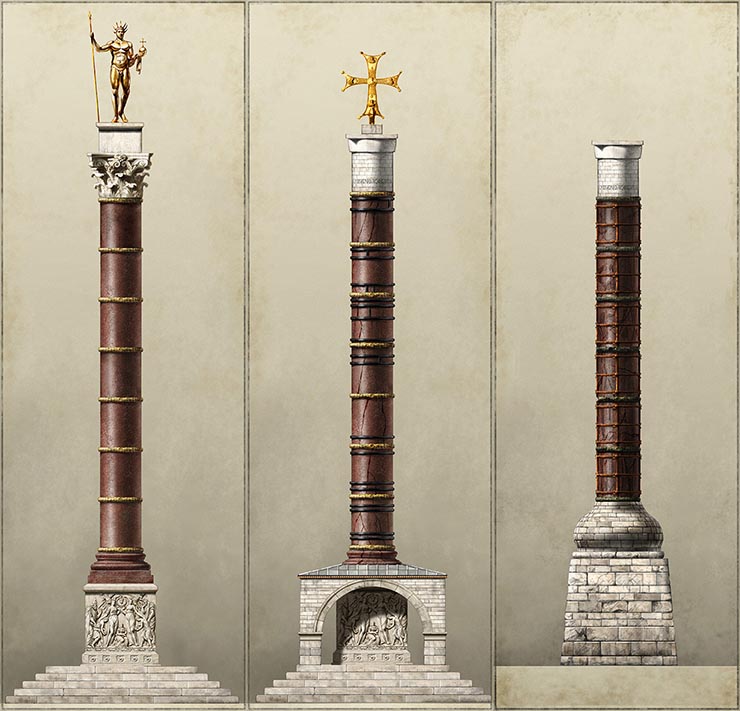
The Colossus of Barletta
Huge statues - including gigantic, gilded equestrian ones - were still being produced into the reign of Theodosis II and may have lasted until the 7th century into the reign of the Byzantine Emperor Heraclius. The huge Colossus of Barletta is possibly a statue of the 5th century AD Byzantine Emperor Marcian (or Leo?)and may have come from his column which still stands in Istanbul. Bente Kiilerich writes the following about the discovery of the colossus:
'The origin of this enigmatic colossus is totally uncertain. The earliest reference to it is in the Edict of Charles of Anjou from 1309, which notes that it was then lying in Barletta’s harbour as royal property: “ymaginem de metallo existentem in dohana Baroli”. It is further noted in the edict that the legs and arms had been melted down so that the metal could be used for church bells in a neighboring town. Later the Jesuit father G.P. Grimaldi recorded that it was brought to Italy by Venetian crusaders as part of the booty from the Sack of Constantinople in 1204. The ship sunk before reaching Venice and the colossus remained destitute in Barletta’s harbour, until it was re-erected on 19 May 1491, with the missing limbs restored."
In present day Istanbul the Column of Marcian has marks on the top of the column where a great bronze monolith was attached. Unfortunately, since the original lower legs are replaced we can't line up anything to prove it. The statue was most likely looted after 1204 as well. It washed ashore off the coast of Italy missing it's lower legs, arms and the crown of the head. It could have been damaged during it's removal from its column. The arms and cross were replaced in the last 200 years, but must be very close to the original ones. Below you can see a picture of the Colossus with people - the huge scale is obvious.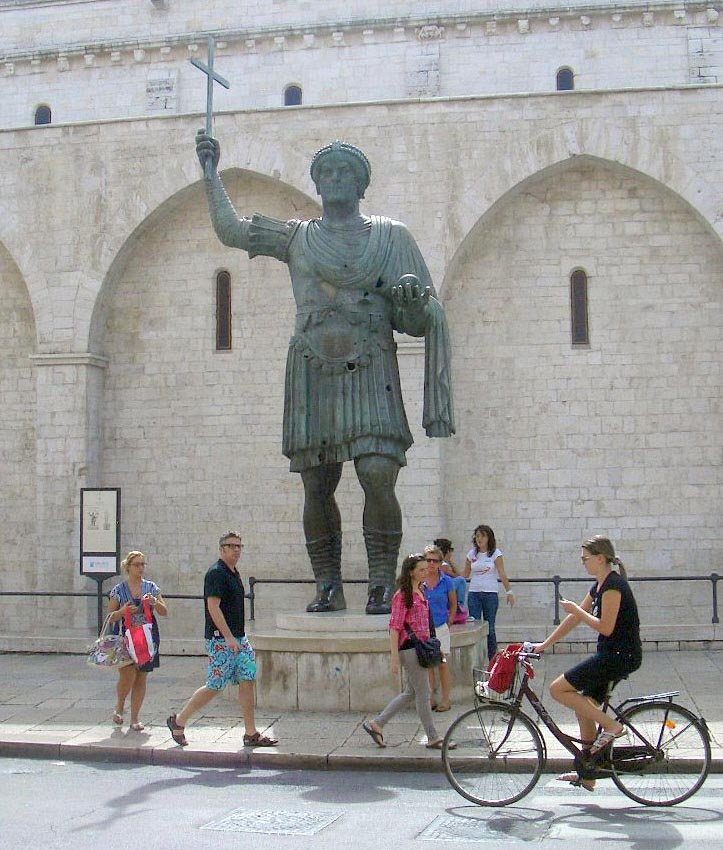
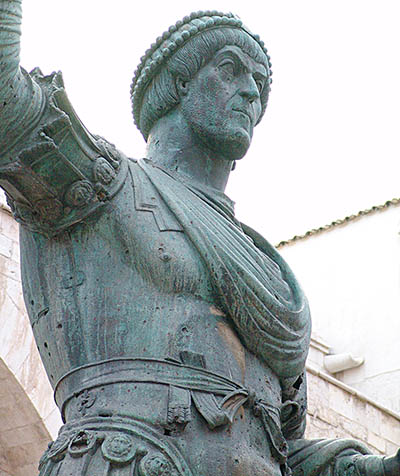 Bente Kiilerich has written an extensive monograph on the colossus - the following is the abstract and her conclusion, which I downloaded from academia.edu:
Bente Kiilerich has written an extensive monograph on the colossus - the following is the abstract and her conclusion, which I downloaded from academia.edu: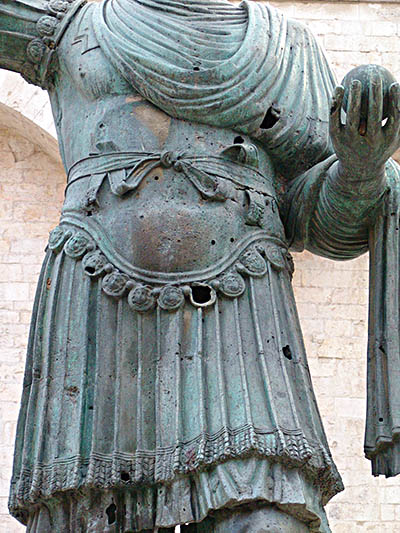
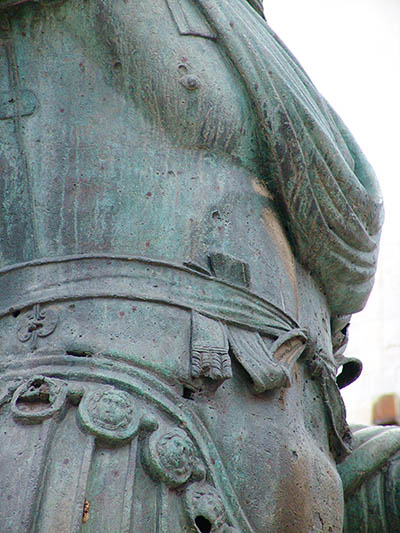
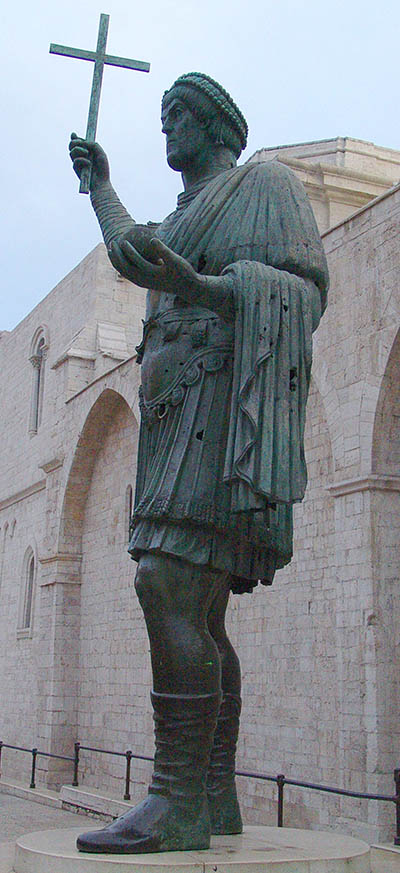 Below is a photo-montage of the Colossus placed on the Column of Marcian
Below is a photo-montage of the Colossus placed on the Column of Marcian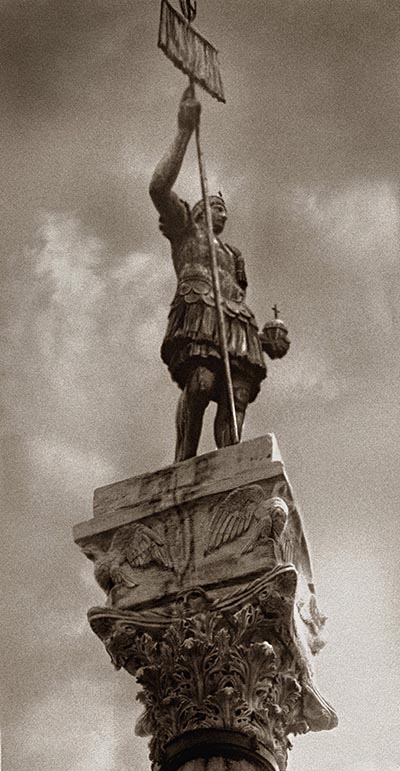
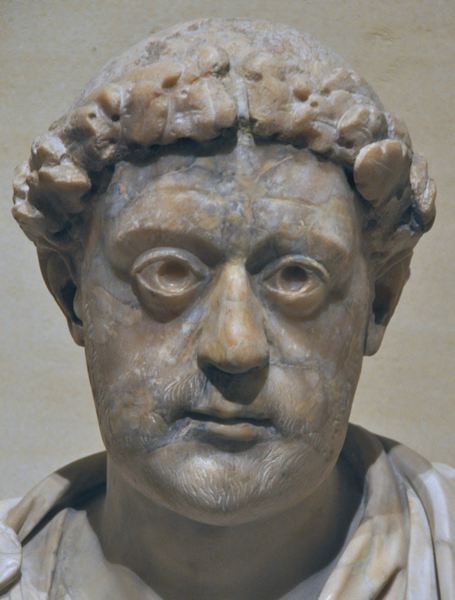

 Above is a reconstruction of the Forum of Constantine with his column in the center. Constantine's Forum was filled with beautiful bronze statues from ancient Greece and Rome. The most famous was the Athena Promachos - "Athena who fights in the front line" - by Pheidias from the Athenian acropolis was brought to the Forum sometime after 465 AD and can been seen to the left of the great column in the reconstruction above. There were many other statues in the Forum including an Aphrodite, a Thetis and an Artemis; and many of animals like dophins and an awe-inspiring elephant. The Forum also had 12 gilded hippocamps, mythical creatures which most people called sea horses.
Above is a reconstruction of the Forum of Constantine with his column in the center. Constantine's Forum was filled with beautiful bronze statues from ancient Greece and Rome. The most famous was the Athena Promachos - "Athena who fights in the front line" - by Pheidias from the Athenian acropolis was brought to the Forum sometime after 465 AD and can been seen to the left of the great column in the reconstruction above. There were many other statues in the Forum including an Aphrodite, a Thetis and an Artemis; and many of animals like dophins and an awe-inspiring elephant. The Forum also had 12 gilded hippocamps, mythical creatures which most people called sea horses.



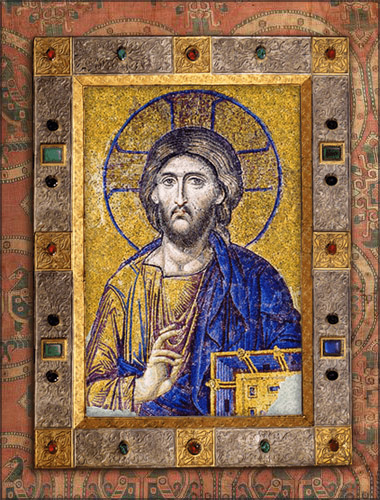

 click here for icons of christ
click here for icons of christ click here for icons of the theotokos
click here for icons of the theotokos click here for icons of angels
click here for icons of angels click here for icons of saints
click here for icons of saints








